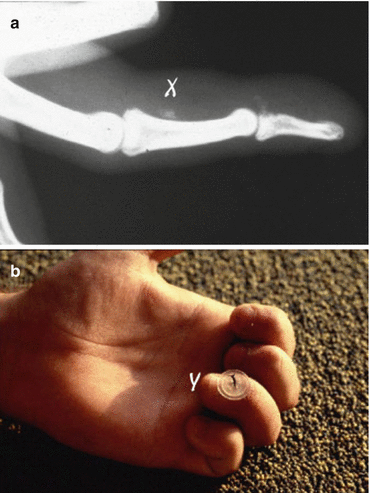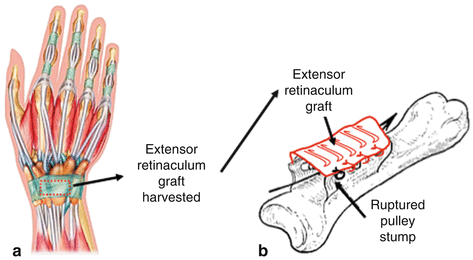and François Moutet2
(1)
Marseille, France
(2)
Grenoble, France
4.1 Tendon Lesions
Regarding climbers’ pathology, spontaneous isolated tendon rupture doesn’t often occur. Closed flexor tendon avulsion at the distal insertion level is much more a rugby player lesion (jersey finger). Actually climbing reinforces osteo-tendinous attachment to the distal phalanx (P3). If rupture occurs, the treatment doesn’t differ that of any flexor tendon injury, and in this case, distal insertion is provided.


Schema 4.1
(a, b) Jersey finger. The avulsed flexor digitorum profundus (FDP) is pulled up in the digital sheath (X). It is fixed back in place through the bone of the distal phalanx (P3). The suture is protected by a button fixed over the nail that will be pulled out on the 45th day postop (Y). Active mobilization, with no resistance at all, is allowed
On the same way, any section occurring during climbing practice will be treated by tendon suture, early active motion with a protection splint, and rehabilitation. The suture must be strong enough to allow mobilization, thin enough to allow a perfect gliding of the repaired tendon in its sheath, and in an unloading position to avoid strong tension. In such lesions, the key point is – whatever the zone is – not to apply too much strength too early on the repaired digit at least for 2 months.


Schema 4.2
Flexor tendon zones international classification (Verdan & Michon). Zone II is the ancient “no man’s land.” It became the “one man land.” The one is and must be the hand surgeon
4.2 Ganglion Cysts
At the wrist level and at the digitopalmar crease (tenosynovial cyst), they are not more frequent as regards the general population. Usually they are not due to a traumatic lesion but rather to overuse conditions. They may be easily cured by surgical resection. People have to bear in mind that this phenomenon is an inflammatory response of the synovial sheath or conjunctive tissue transformation; consequently, cysts have to be removed only if they are still present after a period of 6 months on. That is especially true at the wrist level where they can come and go several times before stabilization.
4.3 Flexor Tendon Pulley Ruptures
As regards climbers’ activities, pulley rupture is the most common upper limb lesion. The digital sheath and flexor tendon pulley system, as shown in the anatomy chapter, is a necessary structure. When partially or totally destroyed, the range of movement and the grip strength are severely impaired especially regarding climbing performance. So especially at A2 (75 %) and A4 level, surgical reconstruction is necessary. Reconstruction uses a part of the extensor retinaculum harvested at the dorsal aspect of the wrist. This structure is the pulley of the extensor apparatus and then has the same mechanical properties and histologically the same nature, so it’s the perfect reconstruction material. The graft is put in place of the ruptured pulley.


Schema 4.3
Digital pulley reconstruction. (a) A retinaculum extensor graft is harvested at the dorsal aspect of the wrist. (b) The graft is fixed to the stumps of the ancient pulley
That procedure requires a 3-month total rest period: a month and a half with a massive splint (wrist flexed at 30°, MP joints flexed at 70/80°) and then another month and a half with a rigid ring which protects the reconstructed pulley. Return to climbing may be authorized only after that “incompressible” 3-month period. The climber has to respect this complete rest, because if he doesn’t, a second rupture will occur.
When a partial rupture occurs, surgery is not always necessary. In such cases, wearing a rigid ring protecting the concerned pulley, for a month and a half, will be usually sufficient.
Stay updated, free articles. Join our Telegram channel

Full access? Get Clinical Tree








